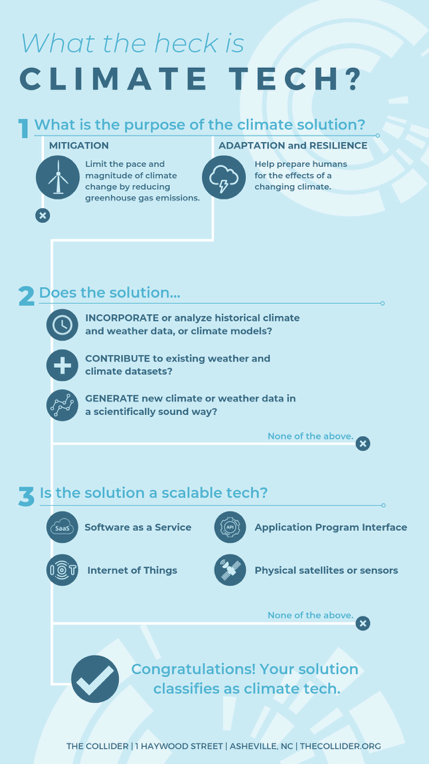ClimateTech: A New Investment Genre for Startups Emerges


There’s HealthTech. FinTech. InsurTech, AdTech and AgTech. And biotech, of course. Is “ClimateTech” the newest emerging sector where technology-based startups are entering to combat climate change?
Given how quickly savvy entrepreneurs identify ways to transform an industry, it seems only natural that they are identifying tech-aided advances to help solve climate adaptation and resilience challenges. Activity certainly is accelerating and it will prove interesting to see if socially responsible investors take note. After all, venture capitalists may be wary since many made money-losing bets during the so-called CleanTech era in the 2000s.
So, what is ClimateTech? The Collider, a three-year-old Asheville, N.C. nonprofit dedicated to helping the world prepare, adapt and become resilient as climate change intensifies, defines this term as a “rapidly emerging industry in which data-driven products are developed to enable communities, companies, and governments to understand their risk and exposure to the effects of climate change and take action to adapt and become resilient.” (Take a look at The Collider’s infographic below.)
At least three resilience-focused ClimateTech categories can be classified. They are:
- Energy resilience: Two years ago, according to one report, utilities had invested over $2.9 billion in distributed energy companies. Distributed generation falls into the classic CleanTech venture capital definition, and wealthy investors such as Bill Gates and Jeff Bezos have been pouring money into the billion-dollar Breakthrough Energy Ventures fund for distributed generation and other energy tech. For instance, they have funded Sierra Energy, whose waste-to-energy gasification technologies are modular. And the Australian startup Omnicarbon provides the first artificial intelligence core smart city platform to partner with cities to achieve a sustainable, resilient and decarbonized future.
- Climate risk analytics: While investors become more sophisticated in how they harness data to select the startups most likely to thrive, there also is money to be made in investing in the analytics themselves. For example, Moody’s acquired Four Twenty Seven, Inc., making it an affiliate and giving the rating agency access to a giant database of granular climate change risk analytics. Bloomberg reasoned that the acquisition potentially signifies “the beginning of a major shift in how markets price risks related to climate change.”
- Agriculture: Sure, this could fall under AgTech, but such precision agriculture products as software management, data analytics, water efficiency and seed innovations are closely related to climate change, recruiting younger farmers and luring venture capital investors focused on agriculture, including Avrio Capital and Anterra Capital. Boston-based Indigo Agriculture, for one, develops microbial and digital technologies that improve environmental sustainability and consumer health, among other things.
While social impact investors haven’t been shy in investing in disaster recovery and big tech firms have donated sizably after extreme events, ClimateTech goes beyond do-gooding to find bottom-line benefits. While traditional CleanTech investments have slowed, these three climate resilience tech investment areas suggest there’s money to be made while combatting climate change.
In fact, the genre is so ripe that a ClimateTech Wiki has emerged. The site offers a platform for both mitigation and adaptation/resilience technologies; give it a look and consider what climate resilience you can invest your time or treasure in.
Image credit: Hugh Han

With Transatlantic Voyage, Greta Thunberg Joins Movement to Clip Airline Sector's Wings


Teenage Swedish climate activist Greta Thunberg’s announcement late last month that she would sail across the Atlantic to attend the United Nations Climate Summit in New York this September was met with approval by her fellow Swedes and other Europeans who are giving up air travel to reduce their carbon footprint in a growing “flight shame” movement.
That has airline industry officials worried, even if it has yet to seriously make a dent in air travel. Alexandre de Juniac, head of IATA, warned “Unchallenged, this sentiment will grow and spread,” at an airline summit in Seoul in June, according to Reuters.
The airline industry represents 2.4 percent of global energy-related CO2 emissions, according to Carbon Brief: but its emissions are growing fast, with passenger numbers projected to double to 8.2 billion in 2037.
In Sweden, the airline industry is feeling the impact of “flight shame,” from the Swedish “flygskam”, where the grassroots initiative Flygfritt has convinced 14,500 Swedes to renounce air travel in 2019 (aiming for 100,000 in 2020). Swedavia, which operates Sweden’s 10 busiest airports, reported domestic passenger numbers are down by 8 percent from January to April this year, compared to a 3 percent decline in all of 2018, according to the Guardian.
For Thunberg, who stopped flying in 2015 and got her parents to join her, there was no question that she had to find a different way to get to New York, as she explained to U.S. Representative Alexandria Ocasio-Cortez, who kicked the climate debate in high gear in the U.S. with the Green New Deal. In a conversation arranged by The Guardian, Ocasio-Cortez told Thunberg, “If you land in New York, we will give you a Queens’ welcome!”
Thunberg’s school strike movement to shine a light on climate change inspired student strikes in more than 1,600 cities in 125 cities. Whether her decision to cross the Atlantic on a zero-emissions sailboat sparks a resurgence of ocean travel remains to be seen—but her influence among youth activists is considerable.
Thunberg will be crossing the Atlantic with Team Malizia on a 18-metre (60ft) yacht, a high-speed planing monohull built for the 2016-17 single-handed, non-stop round-the-world Vendée Globe race. The vessel is owned by German property developer Gerhard Senft and sponsored by the Yacht Club de Monaco. Thunberg said she is refusing all commercial sponsor logos and “no money or future payments are involved.”
Such vessels don’t represent a realistic solution to most climate activists who spurn transatlantic air travel. There will always be exceptions, like the couple who had given up air travel for their low-carbon lifestyle but needed to travel from Switzerland to Australia for a wedding and spent 200 hours on trains and a fortnight on a cargo ship.
Meanwhile, there has been more talk about all-electric airplanes, but that young industry most likely will need many more years before such options can scale up. Meanwhile, citizens concerned about the rapid growth of the global travel sector have plenty of targets in their line of sight.
The cruise industry could next be a likely focus for climate activists; a passenger’s carbon footprint triples in size when taking a cruise, reports Forbes. Along with other environmental impacts, such as the disposal of sewage and other wastes in the oceans, his industry has been under increasing pressure to address these challenges.
One example of the global pushback against cruise lines is that last year, Norway pledged that its scenic fjords will become zero emission zones by 2026 and will only welcome electric ships. Over the past several years, Venice and other cities in Italy have demanded that cruise operators make their ships “compatible” with local infrastructure and environment. And officials in Dubrovnik, Croatia signed a memorandum of understanding with the global cruise industry as locals feared the surge in port visits has aroused fears that the popular destination “has lost its soul.” Watch for other countries to follow the lead of Norway, Italy and Croatia—in which case Greta Thunberg may have more travel options the next time she decides to venture away from her hometown.
Image credit: RedCharlie/Unsplash
Buyout Benefits: Retreating from U.S. Climate Risk Zones


John Holdren, who was President Barack Obama’s science advisor, has contended that when it comes to climate change, we basically have three responses: “mitigation, adaptation and suffering,” with a combination of them offering the way forward. Within adaptation, three choices also exist: adapt, prepare or retreat.
But in the United States, what constitutes retreat? Or, as a friend of mine at the Federal Emergency Management Association, reflecting his military background, prefers to term it: “retrograde” or “retrograde in force.” Another way to put it is by using the Department of Housing and Urban Development’s favored term, “buyouts.”
HUD, arguably, is the biggest retreater. Its Community Development Block Grant (CDBG) program, FEMA’s Hazard Mitigation Grant program, as well as various state and local government programs that match FEMA-funded efforts, have paid for buyouts in climate risk zones across the country. The state of New York, for instance, has used CDBG-Disaster Recovery program funds to purchase 1,277 homes in its New York Rising program since 2015, while New York City acquired 120 homes in its Build it Back Program after Hurricane Sandy.
Federal rules require a buyout to be the acquisition of real property—residential, commercial, agricultural or vacation—and it must be removed and follow subsequent land use and deed restrictions that require the land be for non-structure use. Generally, buyouts are valued at the pre-disaster price and are available for properties located in a flood plain or disaster risk-reduction areas defined in a post-disaster action plan.
As for buyout benefits, there are several reasons why they may tempt citizens, including:
- Move people and their homes out of harm’s way, minimizing repetitive loss of property.
- Restore the natural sponge function of a flood plain.
- Provide additional green space and coastal or rivers-edge buffers.
- Offer long-term cost savings to a municipality by decreasing disaster and damage-recovery fund demands.
However, recovery programs face challenges. In many instances, there isn't enough public or political will to support a buyout program. As Pete Plastrik, vice president at Innovation Network for Communities, notes in his coauthored report, Can it Happen Here? Improving the Prospect of Managed Retreat by U.S. Cities, leaders “can foresee that considering retreat would produce substantial political, financial and emotional pain locally—an array of immediate and intimidating difficulties with little gain in the short run.”
Plus, since the programs are generally voluntary instead of being about taking property by eminent domain, low participation can result in a checkerboard of houses with some neighbors taking the buyout and others staying put. The results include decreased cost savings, the loss of any infrastructure buffer and opportunities to avoid repetitive losses. In addition, tax base implications can arise if residents move outside of the local government area and bought-out residents struggle to fund replacement housing at a price that matches their buyout proceeds. Of course, the social impacts, both on those who move away from their community and those who stay, are real and quantifiable.
As the number of buyouts grows over time, paid for with U.S. taxpayer dollars and forever impacting affected households and communities, important questions should be addressed:
- What are clear and replicable guidelines and policies for appraising home values that protect both tax payers and homeowners?
- How can we ensure those who move do not resettle in places that face future risks – which would mean potentially repeated future buyouts, especially since coastal families might choose to find homes with familiar coastal assets?
- Since lower-income housing, including public housing and mobile homes, have historically been developed in flood plains, how can these residents be accommodated in dignified affordable homes out of harm’s way?
These are serious questions to ponder—and they will not recede anytime soon.
Image credit: Jim Gade/Unsplash
Twilio.org Pledges Enormous Boost for NGOs' Crisis Response


“When it comes to people in crisis, communications can be the bridge between life and death,” tweeted Erin Reilly, vice president of social impact at Twilio and general manager of its social impact arm, Twilio.org, earlier this year, as she described the drive behind Twilio’s social mission that is intertwined with its core business.
Pledging 50 percent of resources for good
Today, Twilio.org pledged to dedicate 50 percent of its resources to nonprofits working in crisis response related to substance abuse, sexual assault, mental health, domestic abuse and disaster relief. This is in addition to the $5 million in grants Twilio.org will commit to nonprofits from its Impact Fund by the end of 2019. Twilio.org also has 3,500 Impact Access program members, which are nonprofits that have received $500 of credit in donated product, representing an additional $1.75 million in product donations. This adds up to $11.25 million in Twilio.org grants and product donations since 2017.
Twilio is a $16 billion cloud communications company that facilitates communications by enabling phones, Voice over Internet Protocol (VoIP), and messaging to be embedded into Web, desktop and mobile software. Launched in 2008, today Twilio has 64,000 customers across 180 countries, with a revenue of approximately $650 million in 2018. Some of its customers include Match.com, Airbnb, American Red Cross, Whatsapp, Salesforce and the New York Times.
The social impact journey of Twilio.org
“Early on, we saw a trend of nonprofits using Twilio to help advance their missions, so we wanted to make sure that our technology is easily accessible to them," Reilly told 3p. "That’s why we launched Twilio.org in 2013 by providing $500 credit and 25 percent discount to qualifying nonprofits. We generate revenue from nonprofits that pay us to use our product, albeit at a discounted rate. That gives Twilio.org resources to reinvest into social impact."
Twilio.org gained more momentum by participating in the Pledge One Percent movement, committing 1 percent of the company’s equity to fund Twilio.org for 10 years. “Prior to taking the pledge, we knew we wanted to prioritize social impact, but we hadn’t committed a number to the cause," Reilly explained when asked about the rationale behind participating in the program. "We had already donated and discounted our product, and engaged our employees, but we wanted to step it up by committing our equity. Pledge One Percent provided a clear precedent that we could follow. Even when we acquired Sendgrid, who was also a Pledge One Percent member, we added the value of one percent of its equity to Twilio’s pledge.”
Crisis Response Technology Network launches for nonprofits
Twilio.org’s commitment of 50 percent of its resources for nonprofits working in crisis communications also includes the establishment of the Crisis Response Technology Network, which will bring together organizations delivering crisis response at scale via technology. Engineers and program specialists will convene quarterly to identify barriers and opportunities to utilizing technology to improve response times and serve more people who are in crisis.
Charter members of the network as announced at Twilio's Signal conference are nonprofits RAINN, Partnership for Drug-Free Kids (Center on Addiction), Child Helpline International, Tech Matters, International Rescue Committee, Save the Children and the Trevor Project. The Network is open for membership to nonprofit organizations that are utilizing communications technology to better serve communities in times of crisis.
The strength of the triple bottom line
Twilio’s venture into social impact has not only strengthened the value proposition of the company, but also its relationship with clients and employees: “Our commitment to Twilio.org has also reassured our for-profit clients," Reilly told us. "When a business sees our commitment to supporting a suicide helpline and staking its effectiveness on the reliability of our networks, they know that we can handle big challenges. For our employees, the Twilio.org commitment has a similar effect. Employees are going to do the extra work to test the platform because they know that every message matters.”
“At the end of the day, social impact will not be successful if it’s a ‘nice-to-have,'" she concluded. "I believe that the success of the ‘for-profit’ and ‘for-good’ arms of Twilio are intertwined. As one grows, so does the other. Creating a virtuous cycle between the two and actively making them inextricably tied is important for the sustainability of both efforts."
Image credits: Twilio.org; Arseny Togulev/Unsplash
Cloudflare Takes A Stand Against Online Lawlessness


U.S. companies have always been sensitive when it comes to brand reputation, and those concerns have grown increasingly fraught during the Trump administration. Business leaders are generally reluctant to criticize any elected official for bad behavior, especially the President of the United States. That makes it difficult for business stakeholders to speak out when the President issues public statements that are racist by any objective standard.
Nevertheless, some companies have found their voices, by staking out the moral high ground on broader terms. The latest example is the leading web hosting service provider, Cloudflare.
Cloudflare draws a clean, bright line
Cloudflare has previously been criticized for continuing to provide web services to the online discussion group 8chan, despite its notoriety as a gathering place for racist commentary, among other offensive topics.
The company finally took action this week, in response to last weekend’s mass murders in El Paso, Texas and Dayton, Ohio.
In blog post his company released earlier this week, Cloudflare CEO Matthew Prince announced the termination of services to 8chan. He also explained that decision was made after reports surfaced that the El Paso shooter had posted a racist manifesto on the message board shortly before killing 22 people at a local Walmart.
Prince did not overtly draw the connection to the President’s racist rhetoric, but he did not have to. Reporters and other observers were quick to point out that the El Paso shooter’s manifesto closely echoed the President’s frequent references to an immigrant “invasion,” among other rhetorical similarities.
Instead, Prince drew attention to a pattern of incitement to lawlessness on 8chan. He noted at least two other recent episodes in which a white terrorist broadcasted his intentions on 8chan before going on a killing spree, one in New Zealand and one in California.
In addition, Prince was careful to make the distinction between censorship over language and responding appropriately to lawlessness. He stated that “8chan has repeatedly proven itself to be a cesspool of hate,” but he also stated that Cloudflare’s decision to terminate service was not based on “hate-filled” content. The decision was based on lawless content, specifically content that incites others to violence.
As Prince explained:
“We reluctantly tolerate content that we find reprehensible, but we draw the line at platforms that have demonstrated they directly inspire tragic events and are lawless by design. 8chan has crossed that line. It will therefore no longer be allowed to use our services.”
Calling out bad behavior
Prince could have just as easily been referring to a long series of public statements by President Trump attacking people of color and referring to an “invasion” of non-whites, language directly echoed by the El Paso terrorist.
However, rather than drawing a connection to the President’s statements, Prince echoed the anti-racist stand taken by the children’s publishing company Highlights as well as more recently, Under Armour CEO Kevin Plank and Siemens CEO Joe Kaeser.
In all three cases, the companies did not criticize the President as a person for being a racist. Instead, they underscored the importance fundamental human values.
For Highlights the issue was “human decency, plain and simple,” in responding to the President’s policy on the treatment of immigrant families. More recently, Plank used a personal Twitter post to respond to the President’s attacks on four sitting U.S. Representatives, all four of whom are women and people of color. Plank’s Twitter message drew attention to Under Armour’s 2017 video launching its “We Will” community engagement program, focusing on the diverse population of Baltimore, his company’s home town.
Kaeser was more explicit. He responded to the same series of attacks on Twitter by affirming the values of “freedom, tolerance, and openness” against the “racism and exclusion” that now characterizes the office of the current U.S. President.
In the case of Cloudflare, Prince also drew a broader picture. He explained that dropping 8chan as a customer solved a problem for the company, but it “does nothing to address why mass shootings occur” and it “does nothing to address why portions of the population feel so disenchanted they turn to hate.”
The “Rule of Law” and the limits of corporate activism
In the absence of leadership from the federal government, corporate leaders have been stepping up to advocate for issues of broad social concern including gun safety, LGBTQ rights, climate change as well as immigrant rights.
Corporate social responsibility has its limits, though, and Prince’s blog post was also an appeal for government to step in and set standards.
Prince framed his case for government standards under the concept of the “Rule of Law,” as globally recognized principle.
Here in the U.S., the federal court system defines the Rule of Law as a system of accountability:
“Rule of law is a principle under which all persons, institutions, and entities are accountable to laws that are:
- Publicly promulgated
- Equally enforced
- Independently adjudicated
- And consistent with international human rights principles.”
For Cloudflare, Prince explained, these principles have translated into policies that are “transparent and consistent.” He credited that approach for building the company into a global leadership role as an internet service provider leadership role, but he also argued that corporate activism can only go so far:
“While we've been successful as a company, that does not give us the political legitimacy to make determinations on what content is good and bad. Nor should it. Questions around content are real societal issues that need politically legitimate solutions.”
For a democratic society, that legitimacy must come from the voting public, through their elected representatives.
In effect, Prince’s blog post is a call for the voting public to pick up where political leadership has left off.
Meanwhile, it appears that corporate activism is still growing in strength.
After Cloudflare dropped 8chan, the site reportedly entered into an agreement with another web services called BitMitigate. That company comes under the umbrella of a Washington-based firm called Epik, which is known for its hosting of the hate sites Gab and Daily Stormer when they lost their providers.
Apparently, the addition of 8chan was too much for Epik’s web own services provider, Voxility. As of this writing, Voxility has announced that it is no longer working with Epik, leaving 8chan offline and in search for another provider.
Join us at 3BL Forum: Brands Taking Stands – What’s Next, at MGM National Harbor, just outside Washington, D.C., on October 29-30, 2019. The two-day event will continue our newly established tradition of bringing corporate leaders together on a fast-paced main stage, keenly focused on the ‘why’ and ‘how’ behind their thinking as we navigate a rapidly changing business environment. Receive a 25 percent discount using this code PUNDIT2019AUGUST when you register here during the month of August, 2019.
Image credit of El Paso, Texas: David Mark/Flickr
When Brand Reputation Confronts Employee Activism


Several household brands have been in the news for taking a stand on racism and confronting other offensive content in traditional and social media. That concern is also at work behind the scenes, within the enormous business-to-business (B-to-B) sector. A recent decision by the leading independent public relations agency Edelman provides an interesting example of that dynamic, because it illustrates how employee activism can have an influence on high-level decisions on matters of brand reputation and corporate responsibility.
Why this global P.R. firm dropped Geo Group
Edelman has been in the news recently after reports surfaced that it agreed to represent the for-profit prison company Geo Group last spring, only to disentangle itself from the relationship earlier this summer.
That decision is not difficult to understand from a brand reputation perspective. The field of for-profit prisons is not a particularly savory one, and Geo Group has earned notoriety in recent months for documented incidents of inhumane treatment of immigrants at some of its facilities.
Geo Group is not the first high profile name to be turned away by Edelman in concert with a broader social trend.
Back in 2015, The Guardian reported that Edelman cut its longstanding relationship with the American Petroleum Institute, spinning the business off to a former subsidiary, Blue Advertising. The decision followed upon a movement within the public relations field to stop representing climate change deniers.
As another indication that the Geo Group decision may have been carried out with brand reputation in mind, earlier this summer Edelman released a comprehensive survey titled, “2019 Edelman Trust Barometer Special Report: In Brands We Trust?” The report highlights a shift in the way consumers perceive brand reputation. Turning out a good product is no longer enough to protect a company’s reputation, Edelman's researchers have found (emphasis added):
“…consumers have many more reasons to question how much they trust a brand. Will it protect their data and privacy? Use automation responsibly? Tell the truth in this era of disinformation? In short: Can consumers trust a brand do the right thing?”
The evolving role of employee activism
To be clear, it is possible that high-level executives at Edelman took the lead in terminating the relationship with Geo Group for reasons other than brand reputation. In an official statement provided to the media, an Edelman spokesperson explained the decision as an ethically neutral one.
However, last week the trade publication Ad Week reported at length on the episode and suggested that brand reputation did play a central role in the decision. Additionally, Ad Week suggested that employee activism was also at work.
Citing anonymous sources both inside and out of Edelman, Ad Week reported that "the firm opted not to work with The Geo Group because of internal pressure from staffers protesting the partnership and worries that the potential blowback could endanger relationships with other clients.”
Ad Week based its reporting partly on two insider sources at Edelman, who claimed that employees spoke up after receiving an internal email announcing Geo Group as a client.
The publication also noted the relationship between brand reputation and employee activism:
“Executives were concerned about employees’ objections to the business, the sources said, but they also feared public awareness of the relationship might damage Edelman’s reputation.”
Among other trade publications to carry the story, PR Week also cited a report in The New York Times, indicating that Edelman dropped Geo Group after several “employees were ‘disturbed’ by the work and asked not to work on it.”
Appearances, aside, employee activism works
Even where employee activism does not achieve immediate results, companies can still suffer reputational damage.
A worst-case scenario was recently offered up by the home furnishings company Wayfair, which suffered through a high walkout demonstration at its headquarters in downtown Boston when it failed to respond to employees’ concerns over the Trump administration’s treatment of immigrants.
The impact on talent recruitment can be especially concerning when other companies in the same field have taken steps to listen and respond.
The Edelman decision, for example, has thrown additional light on a reported “ethical crisis” over immigration issues at Ogilvy, another leading public relations firm.
That is no idle concern. In 2017 the research and consulting firm Povaddo found that “more than half (57 percent) of those working in America’s largest companies feel that their employers should play a more active role in addressing important societal issues.”
Those findings have been borne out at Facebook, for example, where employees petitioned to take Peter Thiel off the company’s board of directors over his support for then-presidential candidate Donald Trump during the 2016 election cycle.
At Amazon, employees have been advocating for the company to step up its efforts on climate change. At Google and Microsoft, employees have been petitioning their companies over surveillance and immigration issues.
None of these instances have had a direct or dramatic impact on high level executive decisions — yet. As top firms compete for talent and loyalty, high level decisions about brand reputation will become increasingly entwined with the social concerns of employees.
Join us at 3BL Forum: Brands Taking Stands – What’s Next, at MGM National Harbor, just outside Washington, D.C., on October 29-30, 2019. The two-day event will continue our newly established tradition of bringing corporate leaders together on a fast-paced main stage, keenly focused on the ‘why’ and ‘how’ behind their thinking as we navigate a rapidly changing business environment. Receive a 25 percent discount using this code PUNDIT2019AUGUST when you register here during the month of August, 2019.
Image credit: Hédi Benyounes/Unsplash
The Video Game Industry Could Sure Use a Sanofi Moment


Remember when Roseanne Barr lost her job last year after a late-night racist Twitter rampage, which resulted in ABC firing her from her show's reboot? Barr blamed her use of the prescription sleep aid Ambien for her behavior, but the drug’s manufacturer, Sanofi, was having none of it. Someone alert at the social media controls of Sanofi tweeted, “While all pharmaceutical treatments have side effects, racism is not a known side effect of any Sanofi medication.”
It was a great moment for the pharmaceutical industry, of which the sector has had few in recent years considering all the sordid stories and litigation in which many in big pharma find themselves mired.
The video game industry could use a Sanofi moment.
In the wake of the tragedies that occurred in El Paso and Dayton, plenty of politicians, including the U.S. president, have directed much of the blame at video games. Many of these companies’ publicly-traded stocks dropped this Monday after leaders including U.S. House Minority Leader Kevin McCarthy tied last week’s violence to gaming.
There’s no shortage of research that has shown that there are no links to video games and violence akin to what to caused over 30 deaths last weekend. Mind you, this is an old argument: in the early 1940s, New York City Mayor Fiorello LaGuardia blamed pinball machines for a bevy of social ills. Fast forward several decades, and the record shows that academic studies, like this one published earlier this year, have confirmed that no matter how violent video games may be, there is no link to aggressive behavior.
But that stubborn argument persists, even though simple logic dictates that video games are found in almost all countries on earth – but none has the level of gun violence to the degree that the U.S. has. Plus, as a 2015 Pew Research Center study pointed out, video games are enjoyed by all genders, ethnicities and races.
Yet as an industry, the video game industry has largely been silent and has allowed various leaders define its impact on society. A quick review of leading gaming companies, including Ninendo, Activision Blizzard, Namco, King Digital and even Zynga (okay, well they are the Farmville and Words with Friends people), don’t reveal a peep – either on their site or in emailed statements disseminated to writers, journalists or bloggers. The same goes for Microsoft and Sony.
One could argue that speaking out only puts these companies, executives and employees in an uncomfortable position as they are no longer above the fray. Plus, these accusations have gone on for years, but U.S. consumers still buy and play video games.
But food and beverage companies have long fought back against accusations, and scientific evidence, that their products can have a negative impact of public health. We’ve watched pharmaceutical companies dodge responsibility for the opioid crisis. Giant tech firms have also been vocal in countering criticism that their business practices led to the manipulation of U.S. elections.
One of the view gaming industry executives to push back is the CEO of Take-Two Interactive’s CEO, Strauss Zelnik. During an interview Monday with Barron’s, Zelnik, who is at the helm of the company who has given us Grand Theft Auto, said:
“We’re just sickened and saddened by these senseless tragedies. That said, blaming entertainment is irresponsible. Moreover, it is highly disrespectful to the victims and their families. The fact is entertainment is consumed world-wide...but gun violence is uniquely American. So we need to address the real issues.”
Like several of its publicly-traded competitors, Take-Two’s stock took a hit shortly after the president’s statement about the El Paso and Dayton shootings, only for it to have rebounded and recovered any losses as of press time.
And no, so far we haven’t seen any ties between Grand Theft Auto and violence.
The bottom line is that the video game industry has science, academia and common sense on its side. These companies’ leaders could do a society a favor by pointing out the facts – and in turn urging politicians to redirect their focus on solving this massive problem, instead of deflecting blame and gaslighting the U.S. public.
Join us at 3BL Forum: Brands Taking Stands – What’s Next, at MGM National Harbor, just outside Washington, D.C., on October 29-30, 2019. The two-day event will continue our newly established tradition of bringing corporate leaders together on a fast-paced main stage, keenly focused on the ‘why’ and ‘how’ behind their thinking as we navigate a rapidly changing business environment. Receive a 25 percent discount using this code PUNDIT2019AUGUST when you register here during the month of August, 2019.
Image credit: Alex Haney/Unsplash
Setting our Sights on Plastic-Free Oceans by 2030


The CEO of PYXERA Global suggests four ways corporations can use their influence to move society toward plastic-free oceans by 2030.
Former New York City Mayor Michael Bloomberg recently delivered a commencement address at MIT. On the eve of the fiftieth anniversary of the Apollo 11 touchdown, he called for a new “moonshot”—one to stop climate change. That call, and the financial commitment behind it ($500 million), are surely inspiring.
Stopping climate change is a monumental challenge comprised of dozens of complicated challenges that can be paralyzing to many in their size and scope. Perhaps, instead of seeing the halt of climate change as the lunar landing, people and organizations need to coalesce around the very specific environmental goals they have the best resources to address.
Let’s take ocean plastics. Lately, you can’t scroll through a news feed without seeing articles about the marine debris problem. From photos of marine life impacted, to research proclaiming how much microplastic we ingest each day, to exposés on any one country’s contribution to the problem, much of the public is now paying attention.
In May, I had the chance to participate in a unique event assembled specifically to take bold collective action. The Ocean Plastics Leadership Summit (OPLS) took place in the North Atlantic Gyre, located in the Sargasso Sea – about 1,300 miles southeast of New York City. It was the first event of its kind, bringing together executives and leaders all dedicated to ending ocean plastic waste. With more than 150 corporate executives, NGO leaders, scientists and innovators, we set out to experience the ocean plastics crisis firsthand, both on shore and in the North Atlantic Gyre, a swirling mass of accumulated inorganic waste.
While I had considered myself somewhat knowledgeable about the problem of ocean plastics prior to setting sail, facing the hard facts of the problem was nonetheless sobering. Each year, 8 million metric tons of plastic flows into the ocean—that’s the equivalent of a garbage truck dumping a full load of plastic into the ocean every minute of the year. There may now be more than 5 trillion macro and microplastic pieces floating in the open ocean. If current trends continue, experts predict that, by 2050, the oceans will contain more plastic by weight than fish. We are, according to leading scientists studying this issue, turning our oceans into plastic soup.
At OPLS, a goal of reaching zero ocean-bound plastics in 10 years’ time was discussed. Now that would be a clear and well-defined goal. So how might more corporations use their influence to move us toward a 2030 that sees no more plastics added to our oceans?
First, get your own house in order. Evaluate how much plastic you consume in your day-to-day business operations. Whether you engage an outside expert to help you measure your plastic consumption, or conduct an in-house audit, understanding your operations’ contribution to the plastics problem is critical. If you are a plastic producer, or use plastic as a core element of your products, you have an even greater responsibility to evaluate the type of plastic produced and distributed. Once it is clear the types and sources of plastics in your operations, consider what can be eliminated, what can be replaced with a sustainable product, and what can be diverted to the most appropriate form of recycling. Most companies have little idea of the full extent of their plastic usage, and all can make internal changes that would drastically reduce the plastic going to waste.
Invest both in recycling and its sophistication in your communities. Many U.S. cities with recycling programs are collecting these goods, but due to inadequate infrastructure, are sending newspapers, cans and bottles to landfills or incinerating their waste. Other cities have stopped, or never started, collecting recyclables. This scenario is repeated across the globe, in high- and low-income nations. China’s 2018 restrictions on importing recyclables have exacerbated the amount of plastic waste destined for landfills in wealthier nations, who continue to look to poorer countries to carry the burden. Across the globe, there is a stark need to design more sophisticated ways to recycle at a local level, and corporations have the opportunity to lead investment in this space as material to their businesses.
Treat plastic as a commodity. What if we thought of plastic not as waste but as a resource? This mindset will present tangible incentives to reclaim plastic whenever possible, transforming it from a byproduct with no use or value into a resource that can be reused or converted into any number of creative uses by a resourceful population. Reframing the potential value of plastic in a circular economy is a critical step. As Mr. McGuire said to Benjamin Braddock in the 1967 movie Classic The Graduate, “There’s a great future in plastics.” In 2019, we need to see a great future in collecting and finding new uses for this valuable resource.
Invest in new solutions. If we don’t reimagine our businesses with sustainability in mind, we are missing opportunities. New initiatives such as Loop have figured it out. Loop picks up empty containers from products we use and hygienically refills them so we can reuse the containers. It is essential that we find new ways for people to replace single-use plastic wherever possible, and then scale those solutions to make them broadly accessible—geographically, practically and financially.
It is urgent for all of us to see the relevance of our oceans in every aspect of our lives. Regardless of where you live, the health of the ocean has an impact on your livelihood, health and well-being. If corporations can actively support the transition to a world without plastic waste, we stand to tell a remarkable story of how, over just a decade, we fell in love with a challenge, invested, innovated and saved our oceans.
Image credit: Jürgen Jester/Pixabay
Rust-based Tech May Join Solar PV as a Source of Renewables


Move over batteries, solar photovoltaic (PV) panels and wind turbines. Rust may be the new kid in town as a source of renewable energy. Researchers have long looked for alternatives and complements to the silicon found in solar PV cells – such as graphene and solar thermal. So chalk this up to another technology that could transform how we keep the lights on in the future.
Rust, you ask? Yes, rust, according to a study published in the July 29th issue of the Proceedings of the National Academy of Sciences. Well, not exactly the kind you find on your 1974 Chevy Corvette sitting in your driveway, but, in the new study, rust produced in a lab setting was able to conduct electricity when interacting with salt water.
While more research is needed, this could be exciting news for the renewable energy sector as companies compete for cleaner energy alternatives to non-renewables. According to data compiled by BCC Research, the global market for renewable energy (excluding biofuels) should grow from $636 billion in 2018 to reach $855 billion by 2023.
So how would rust work compared to solar PV panels?
As you may recall from your high school chemistry class, combining metal compounds and salt water is a well-known way of conducting electricity, since chlorine and sodium ions can carry electrical currents. But producing electricity on a large-scale using rust is a bit more complicated than that.
The mechanism behind the electricity generation in the study was highly complex, in fact, involving ion adsorption and desorption. According to the professors behind the study from Caltech and Northwestern University, the process essentially works like this: The ions present in saltwater attract electrons in the iron beneath the layer of rust. As the saltwater flows, so do those ions, and through that attractive force, they drag the electrons in the iron along with them, generating an electrical current.
This process is more commonly known as the electro kinetic effect. According to a press statement put out by Caltech, at its best, the electro kinetic effect can generate electricity with around 30 percent efficiency. For reference, the best solar panels are only about 20 percent efficient.
Could rust really become a viable option?
Back to your Chevy Corvette (or, vehicles looking like those in the photo shown above). Unfortunately, naturally spreading rust is too thick to be mass-produced, and doesn’t spread evenly. To work, the team involved in the study created thin films of rust in their labs that were a mere 10 nanometers thick, thousands of times thinner than a human hair. When salt water flowed over their rust-coated iron, the scientists found that it generated several tens of millivolts.
"For perspective, plates having an area of 10 square meters each would generate a few kilowatts per hour—enough for a standard U.S. home," Tom Miller, Caltech professor of chemistry, told Phys.org, a leading web-based science, research and technology news service. "Of course, less demanding applications, including low-power devices in remote locations, are more promising in the near term."
Low-power devices in remote locations, you say? How about items already in the ocean?
"Tidal energy, or things bobbing in the ocean, like buoys, could be used for passive electrical energy conversion," Miller says. "You have saltwater flowing in your veins in periodic pulses. That could be used to generate electricity for powering implants."
Given that the vast majority of the planet's water is salt water, these researchers could be onto something - maybe even an entirely new form of renewable power production joining the likes of wind turbines, geothermal and of course, solar PV.
Image credit: Kevin Noble/Unsplash
Partnering to Ensure Gender Equality Worldwide


Rawaa is a 12-year-old Syrian refugee living in Lebanon. She loves school and wants to become a teacher.
Nasro, a brave, determined Somali teen, has lived more than half her life at Dadaab Refugee Camp in Kenya. She is at the top of her class and dreams of becoming a doctor.
Adebesi, an accomplished young leader from Nigeria, credits his mother’s education—and his father’s support of her education—for the opportunities he’s been afforded. He advocates for the rights of women and girls and uses technology to improve the health and leadership potential of adolescents.
Three young people. Three inspiring lives that demonstrate the goodness that comes from advancing gender equality.
The business of gender equality
August marks the 99th anniversary of women finally granted the right to vote in the United States. It’s also the 49th anniversary of the Women’s Strike for Equality, which elevated the women’s rights movement. And yet, so many decades later, women continue to face social and economic barriers that limit—or prevent—access to opportunities, not only in the United States but globally. Opportunities that might allow humanity—both women AND men—to achieve their full potential.
Want proof? Here are just a few examples:
- According to the World Economic Forum (WEF), if women play an identical role as men in the global labor market it could add $28 trillion to global GDP by 2025. Yet WEF’s Global Gender Gap Report 2018 estimates it will take 108 years to close the global gender gap at the current rate of change—and 202 years to achieve economic gender parity.
- Researchers at Harvard Business School found that while women run 30 percent of small businesses in the United States, employ 7.9 million people and generate $1.4 trillion in sales, they only receive 7 percent of venture capital funding and 17 percent of small business loan funding.
- According to the Food and Agricultural Organization, if women farmers had the same access to resources as men, there would be 150 million less hungry people in the world.
It’s statistics like these that, in the words of Mahatma Gandhi, make me want to “be the change I want to see in the world.” I believe we can change this unequal, inequitable equation, but only by raising our voices and working together.
As the global head of social impact programs at HP, I work closely with organizations including Women Deliver, Girl Rising, the Clooney Foundation for Justice, Education Cannot Wait, UN Women, and academic initiatives such as MIT Solve and National Association for Community College Entrepreneurship to help build and implement sustainable impact programs to change the equation.
Fostering partnerships rooted in shared values
At HP, building strong partnerships with values-aligned organizations is vital to our ability to optimize and scale impact. This shared-value approach—what I often call Philanthropy 2.0—enables each partner to play to their strengths to the shared benefit of each and of all. It’s not about “delivering aid” or being benefactors; it’s about sustainable impact, together, in a concerted manner.
For example, in 2018, HP and Women Deliver launched “Stories of Advocacy,” a unique 15-month partnership to support Women Deliver’s global Young Leaders Program. The program strives to empower advocates to catalyze gender equality action for girls and women in their communities. HP provides ongoing support, as well as the technology, that enable these leaders to drive their advocacy platforms forward.
At the recent Women Deliver Conference in Vancouver, B.C., I participated in a panel discussion with two of these leaders, Adebisi Adenipekun from Nigeria and Marinella Matejcic, from Croatia. The panel was moderated by HP Canada President and CEO Mary Ann Yule, and we were joined by other HP partners, Girl Rising and The International Rescue Committee, the organizations behind the powerful short film, Brave Girl Rising, which happens to star Nasro.
Listening to how these leaders and our partners use technology to enable their efforts gives us essential insight to continuously reimagine possibilities and reinvent solutions to create sustainable and scalable impact.
Such discussions are important as women remain chronically underrepresented within the technology industry. According to the U.S. Equal Employment Opportunity Commission, only 20 percent of technology executives are women. HP aims to be the destination of choice for women and underrepresented groups seeking careers in technology. It’s a commitment that is reflected in the makeup of our Board of Directors, which is the most diverse of any Fortune 100 technology company.
Harness the power to change lives and improve the world
I left Vancouver feeling even more inspired, powerful and optimistic about the future for women.
As Women Deliver Young Leader and Stories of Advocacy grant recipient Bridget Okeke Chukwudera of Nigeria recently told UN Women, “What motivates me is seeing young girls achieving their potential in life, finishing school, building a career. The need to touch lives and improve the living condition of women and girls in disadvantaged communities inspires me every day.”
Image credit: HP